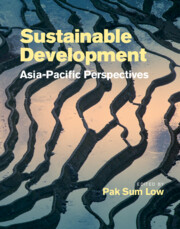Book contents
- Sustainable Development: Asia-Pacific Perspectives
- Sustainable Development: Asia-Pacific Perspectives
- Copyright page
- Dedication
- Contents
- Notes on contributors
- Peer reviewers
- Editor’s note
- Foreword
- Foreword
- Foreword
- Foreword
- Foreword
- Environmental keystones: Remembering Dr Mostafa Kamal Tolba
- Remembering Dr Mostafa Kamal Tolba
- Remembering Dr Mostafa Kamal Tolba
- Acronyms and abbreviations
- SI prefixes
- Unit abbreviations
- Chemical formulae
- Part I Sustainable Development: Theories and Practices
- 1 Asian identities
- 2 On sustainable development
- 3 Sustainability: A scientific dilemma
- 4 Respect and reward: Ecology from the Analects of Confucius
- 5 Sustainable development from an East-West integrative perspective: Eastern culture meets Western complexity theory
- 6 Sustainable urbanism: Measuring long-term architectural merit
- 7 Sustaining wooden architectural heritage
- 8 Green development in China
- 9 Bhutan’s sustainable development initiatives and Gross National Happiness
- 10 A different form of sustainable development in Thailand and Bhutan: Implementation of a sufficiency approach
- 11 The sustainability of food production in Papua New Guinea
- 12 Education for sustainable development: An overview of Asia-Pacific perspectives
- 13 A placemaking framework for the social sustainability of master-planned communities: A case study from Australia
- 14 Poverty, inequity, and environmental degradation: The key issues confronting the environment and sustainable development in Asia
- 15 The challenge of global climate change for international law: An overview
- 16 Sustainable development and climate change negotiations: Perspectives of developing countries
- Part II Sustainable Development: Challenges and Opportunities
- Index
- Endmatter
- References
14 - Poverty, inequity, and environmental degradation: The key issues confronting the environment and sustainable development in Asia
from Part I - Sustainable Development: Theories and Practices
Published online by Cambridge University Press: 23 December 2021
- Sustainable Development: Asia-Pacific Perspectives
- Sustainable Development: Asia-Pacific Perspectives
- Copyright page
- Dedication
- Contents
- Notes on contributors
- Peer reviewers
- Editor’s note
- Foreword
- Foreword
- Foreword
- Foreword
- Foreword
- Environmental keystones: Remembering Dr Mostafa Kamal Tolba
- Remembering Dr Mostafa Kamal Tolba
- Remembering Dr Mostafa Kamal Tolba
- Acronyms and abbreviations
- SI prefixes
- Unit abbreviations
- Chemical formulae
- Part I Sustainable Development: Theories and Practices
- 1 Asian identities
- 2 On sustainable development
- 3 Sustainability: A scientific dilemma
- 4 Respect and reward: Ecology from the Analects of Confucius
- 5 Sustainable development from an East-West integrative perspective: Eastern culture meets Western complexity theory
- 6 Sustainable urbanism: Measuring long-term architectural merit
- 7 Sustaining wooden architectural heritage
- 8 Green development in China
- 9 Bhutan’s sustainable development initiatives and Gross National Happiness
- 10 A different form of sustainable development in Thailand and Bhutan: Implementation of a sufficiency approach
- 11 The sustainability of food production in Papua New Guinea
- 12 Education for sustainable development: An overview of Asia-Pacific perspectives
- 13 A placemaking framework for the social sustainability of master-planned communities: A case study from Australia
- 14 Poverty, inequity, and environmental degradation: The key issues confronting the environment and sustainable development in Asia
- 15 The challenge of global climate change for international law: An overview
- 16 Sustainable development and climate change negotiations: Perspectives of developing countries
- Part II Sustainable Development: Challenges and Opportunities
- Index
- Endmatter
- References
Summary
Asia and the Pacific are blessed with diverse development options and areas rich in natural resources and biodiversity. Its large population, poverty, social inequity, and environmental degradation, however, challenge its development. This chapter, referring to secondary data, examines the sustainable development issues in the poverty-inequity-environment nexus and reveals that the social development so far has not led to a significant transformation, especially in eradicating poverty and inequity, or in mitigating environmental degradation. Three interconnected paradigms – poverty, inequity, and environmental degradation – threaten sustainability because of the continued deprivation of the poor and women of their right to use the local environment and a lack of equal opportunities to access services. The declining quality of the primary source of livelihood, particularly the land, and their lack of assets and low capacity to enter into the development process fall heavily on the poor. The evidence is drawn by referring to various aspects, such as health, malnutrition, employment, and income to strengthen the debate on equity and equal opportunities. In order to reverse the trend, the analysis presented here suggests that a shift in the development paradigm is needed for enhancing the benefits to vulnerable segments of the society and to geographically marginalized or deprived areas. To materialize this, governance for new partnerships and reciprocal relations are needed. The three issues confronting society – poverty, inequality, and environmental degradation – require constant local action aided by supporting and guiding national policy instruments and commitments. Analytical frameworks are presented for diagnosis and to form the basis for discussion. In this respect, the social inclusion process has to make some progress in promoting local authority and proper form of control and ownership for building a sustainable relationship between the environment and the communities, with strong cascading effects.
Keywords
- Type
- Chapter
- Information
- Sustainable Development: Asia-Pacific Perspectives , pp. 155 - 174Publisher: Cambridge University PressPrint publication year: 2022



